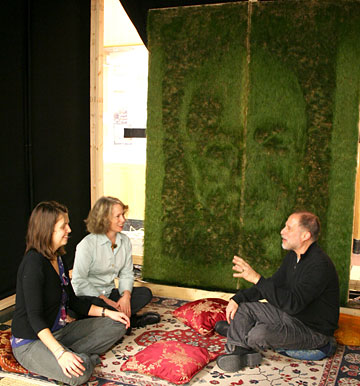Gandhi grows in the grass in Mann Library lobby
By Craig Cramer

During a frantic finals week, hundreds of Cornell students found a little peace and serenity gazing at a grass art installation of a larger-than-life portrait of Mohandas ("Mahatma") Gandhi in the Mann Library lobby.
Students in Hort. 2010, The Art of Horticulture, developed the theme and chose the image for the installation called "A Message From Earth."
"They wanted to convey a message of environmental sustainability along with a message of hope -- not doom and gloom," said Christine Hadekel, the artist and educator in the Department of Horticulture's Garden-Based Learning Program who coordinated a supported for the project with Marcia Eames-Sheavly, the program's youth program leader.
"It was Gandhi who reminded us that 'The earth, the air, the land and the water are not an inheritance from our forefathers but on loan from our children,'" Hadekel pointed out. "And 'to be the change that we want to see in the world.'"
To create the image in an indoor setting, Hadekel and Eames-Sheavly modified a technique used by British artists to develop images outside on lawns. First, Hadekel built two 4-by-8-foot panel frames and stretched burlap over them. Then she sprinkled grass seed on the burlap and placed the panels under a misting system in a greenhouse. After the grass sprouted and covered the panels in a carpet of green, Hadekel moved them to a "darkroom" constructed in the Mann Library lobby. She then projected a high-contrast, black and white, negative image of Gandhi onto the grass with an LCD projector for more than a week.
Where the light hit the grass, it stayed green. The grass that did not receive light withered, forming the image. When the darkroom curtains came down unveiling the work, Hadekel and Eames-Sheavly furnished the space with a rug and cushions, creating an inviting, contemplative space for students in front of the portrait.
Even before the image formed fully, students peered at the eerily lit portrait through peepholes cut in the curtains.
"They had this sense of wonder watching Gandhi grow in the grass," said Howard Raskin, Mann Library's head of operations and outreach, who watered the work twice a day. "It really generated a lot of interest and made the library a more inviting place to be."
"The whole thing worked on many different levels," said Hadekel, pointing out that the picture of Gandhi was taken in Mumbai (then Bombay) in the 1940s, and the installation took place while the terrorist tragedies during Thanksgiving were still fresh in mind.
The installation ended Dec. 19.
"A Message From the Earth" was funded in part by the Cornell Council for the Arts with support from Mann Library and the Department of Horticulture. Raskin and the Mann Library staff helped plan and maintain the installation; J.C. Mosher, horticultural field assistant, and Ron White, horticulture research support specialist, constructed the darkroom; turf specialist Frank Rossi consulted on technical aspects of the project; and Sarah Richards-Desai, horticulture, contributed design and construction help.
Craig Cramer is communications specialist in the Department of Horticulture at Cornell.
Media Contact
Get Cornell news delivered right to your inbox.
Subscribe